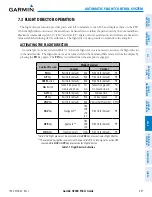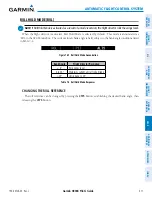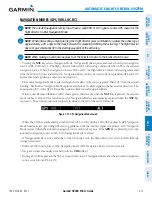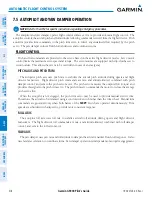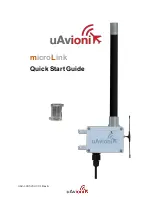
190-00726-00 Rev. J
Garmin G900X Pilot’s Guide
505
AUTOMATIC FLIGHT CONTROL SYSTEM
SY
STEM
O
VER
VIEW
FLIGHT
INSTRUMENTS
EIS
AUDIO P
ANEL
& CNS
FLIGHT
MANA
GEMENT
HAZARD
AV
OID
ANCE
AFCS
ADDITIONAL
FEA
TURES
APPENDICES
INDEX
VNV TARGET ALTITUDE CAPTURE MODE (ALTV)
NOTE:
Armed VNV Target Altitude and Selected Altitude capture modes are mutually exclusive. However,
Selected Altitude Capture Mode is armed implicitly (not annunciated) whenever VNV Target Altitude Capture
Mode is armed.
VNV Target Altitude Capture is analogous to Selected Altitude Capture Mode and is armed automatically
after the
VNV
Key is pressed and the next VNV Target Altitude is to be intercepted before the
Selected
Altitude. The annunciation ‘ALTV’ indicates that the VNV Target Altitude is to be captured. VNV Target
Altitudes are shown in the active flight plan or vertical direct-to, and can be entered manually or loaded
from a database (see the Flight Management Section for details). At the same time as “TOD within 1 minute”
is annunciated in the Navigation Status Box, the active VNV Target Altitude is displayed above the Vertical
Speed Indicator (see Figure 7-11).
As the aircraft nears the VNV Target Altitude, the flight director automatically transitions to VNV Target
Altitude Capture Mode with Altitude Hold Mode armed. This automatic transition is indicated by the green
‘ALTV’ annunciation flashing for up to 10 seconds and the appearance of the white ‘ALT’ annunciation. The
VNV Target Altitude is shown as the
Altitude Reference beside the ‘ALTV’ annunciation and remains displayed
above the Vertical Speed Indicator. The Required Vertical Speed Indication (RVSI) is removed once VNV
Target Altitude Capture Mode becomes active.
At 50 feet from the VNV Target Altitude, the flight director automatically transitions from VNV Target
Altitude Capture to Altitude Hold Mode and tracks the level leg. As Altitude Hold Mode becomes active, the
white ‘ALT’ annunciation moves to the active vertical mode field and flashes green for 10 seconds to indicate
the automatic transition. The flight director automatically arms Vertical Path Tracking, allowing upcoming
descent legs to be captured and subsequently tracked.
Figure 7-14 Automatic Mode Transitions During Altitude Capture
Flash up to 10 sec, Indicating Automatic Transition
Altitude Reference (In
This Case, Equal To
VNV Altitude Target)
c
hanging
the
vnv t
aRget
a
ltituDe
NOTE:
Pressing the
CWS
Button while in VNV Target Altitude Capture Mode does not cancel the mode.
Changing the current VNV Target Altitude while VNV Target Altitude Capture Mode is active causes the
flight director to revert to Pitch Hold Mode. Vertical Path Tracking and the appropriate altitude capture
mode are armed in preparation to capture the new VNV Target Altitude or the Selected Altitude, depending
on which altitude is to be intercepted first.
VNV target altitudes can be changed while editing the active flight plan (see the Flight Management
Section for details).

